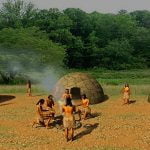Archaic Period (7,000 BC – 1000 BC)

The early part of this cultural period was characterized by warm, dry conditions. Sandy deserts existing in the coastal plain of the Carolinas, but probably, the landscape in the Shenandoah Valley would have been similar to that of eastern Colorado today. Ocean levels were continually rising because of melting glaciers and ice caps in the northern latitudes. By around 5000 BC, western Virginia’s climate was fairly close to what occurs today.
After the concurrent die-off of many large mammals and warming of western Virginia, herds of three ruminant species, deer, bison and elk, dominated the valley. Large herds moved up and down the valley. Much of the lower elevations were grasslands. The herds consumed most trees and shrubs that tried to sprout. During the Archaic Period, the Shenandoah Valley must have been a prime location for hunting.
Four hundred generations of humans in the Shenandoah Valley depended on the large herds of game animals for their primary sources of animal protein. Undoubtedly, there were ethnic groups whose cultures resembled those of the peoples of the Lower Missouri River Basin in the 1700s, who mixed agriculture with big-game hunting.
Bison and elk disappeared from throughout the Southeast around 1740 to 1750. Suddenly, around 1740, the bison and elk throughout the Southeast disappeared. The extinction of bison and elk may have been caused by excessive hunting, but is more likely to have been caused by a cattle disease imported from England, such as brucellosis. Deer populations were decimated by excessive hunting in the early 1700s, but continued to survive in remote locations.
Deer came back to the Shenandoah Valley in the early 1900s. Large herds of deer still thrive in the valley. It is not unusual to see as many as 20-35 white-tailed deer grazing in farm pastures in the daytime. In Shenandoah County, VA alone, 5,580 deer were killed by hunters in 2003. Elsewhere in the Southeast, surviving deer populations have usually become nocturnal and woodland creatures, but in the Shenandoah many continue to behave as diurnal herd animals like their ancestors.
The Native American hunters and gatherers in the Shenandoah Valley of the long period between 8,000 BC and 1200 BC differed little from their neighbors in the Mid-Atlantic Region, but culturally lagged behind peoples living in the Lower Southeast. Whereas pottery began in eastern Georgia around 2,500 BC, it apparently did not arrive in Virginia until around 1,200 BC, and perhaps even later in the Shenandoah Valley. There have been so few archaeological studies of Archaic Period sites in western Virginia, it is impossible to make definitive statements.
Experimentation with agriculture began in the Southern Highlands and Cumberland Plateau as least as early as 3500 BC. The natural environment and climate of the Shenandoah Valley is quite similar to that of the Cumberland Plateau in Tennessee. It is plausible that indigenous plants such as the wild squash were being cultivated in Northern Virginia during the Archaic Period, but there no archaeological evidence has been confirmed at the present time.
